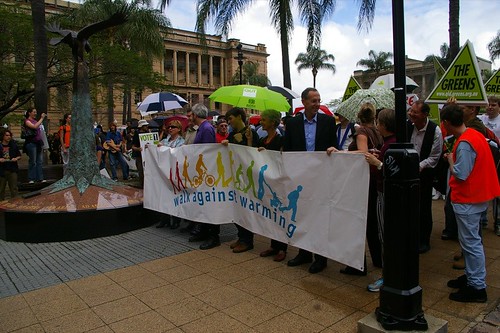6th Feb 2007
From eMagazine.
...
Bush’s call for a zero emission coal-fired plant is an untested idea. “Carbon capture and storage [CCS] or so-called ‘clean coal’ is not a proven technology,” says Sven Teske of Greenpeace International. “There is not a single commercial-scale power plant right now on the grid. We’ve seen through our analysis that wind turbines in some areas are competitive with new coal power plants already, or will be in the next five years.” In terms of nuclear power, Teske says, “Besides all the dangers...it is just too slow. It takes about 10 years to build one. The only European new reactor under construction is in Finland. One year under construction and already it’s one year behind schedule.”
Still, coal companies have plans for more than 100 new coal-burning power plants to be built in the U.S. to meet energy needs. Seventeen of those would be built in Bush’s home state, Texas, where Governor Rick Perry has attempted to speed the process through executive order. And they aren’t of the expensive “clean coal” variety. A National Public Radio story on the Texas coal plants says, “The new power plants in Texas will emit the equivalent of 19 million automobiles’ worth of carbon dioxide every year. When all the new plants are up and running, Texas will send nearly as much carbon dioxide up its stacks as California, New York and Florida combined.” Following suit, more than 700 additional coal plants are scheduled for China and India by 2012.
The U.S. is known as the “Saudi Arabia of coal,” with enough supply to last hundreds of years, and China has a similar coal surplus. Having rejected the Kyoto Protocol, which aimed to cut greenhouse gas emissions, the Bush Administration favors voluntary carbon reductions and supporting technologies that capture carbon dioxide (CO2) emissions before they are released into the atmosphere. But that technology is expensive and the incentive that might come from federal mandate isn’t there.
...
Read the article.
Tuesday, February 06, 2007
Greenpeace Proposes an Energy Revolution
Posted by
National Enquirer
at
11:13 pm
![]()
Labels: bush, carbon emmisions, china, clean coal, climate change, coal, denail, india
Subscribe to:
Post Comments (Atom)





1 comment:
The climate is never static. It is highly variable and constantly changing. There were mini Ice Ages from 1600-1850 AD and also around 450-600. The period around 1000-1250 was warmer than today. Sea levels measured by the Dutch are now around 50cm lower than 1000AD.
Sea levels are actually lower in the Maldives and Kiribati than in 1980.
Global atmospheric temperatures fell between 1940 and 1980.
During the Younger Dryas period 11,500 years ago temperatures changed 10 degrees Celsius is a century.
The past 10,000 years is an exception to the previous million years of intermittent Ice Ages.
The average global temperature for the past 4 billion years is 22 Celsius or 7 Celsius higher than today.
All this is readily available in the per reviewed scientific literature.
Post a Comment